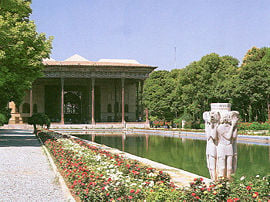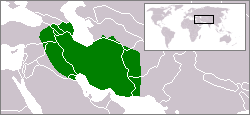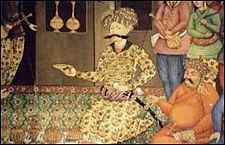The Safavids (Persian: صفویان) were a native Iranian dynasty from Azarbaijan that ruled from 1501 to 1736, and which established Shi'a Islam as Iran's official religion and united its provinces under a single Iranian sovereignty in the early modern period. This clearly differentiated Iran from the Ottomans, who were Sunnis. It was perhaps to perpetuate the distinction of Persian from Arabic culture that attracted the Iranians towards Shi'a Islam—the heartland and sacred sites of Sunni Islam would always be in the Arabian peninsula. Shi'a's sacred sites were much closer—in Iraq, captured by the Safavids in 1623 (but surrendered again to the Ottomans in 1639). The Safavids generally ruled over a peaceful and prosperous empire. Their demise was followed by a period of unrest. They cleverly allied themselves with European powers in order to protect themselves from the Ottomans.
Origins
The Safavid dynasty had its origins in a long established Sufi order, called the Safaviyeh, which had flourished in Azarbaijan since the early fourteenth century. Its founder was the Persian[1] mystic Sheikh Safi al-Din (1254–1334), after whom the order was named.
Sheikh Safī al-Dīn Abdul Fath Is'haq Ardabilī came from Ardabil, a city in today's Iranian Azerbaijan where his shrine still stands. His native language was Old Tati (Āzarī), an extinct Iranian dialect of the north closely related to Persian. He was a disciple of the famed Sufi Grand Master Sheikh Zahed Gilani (1216–1301) of Lahijan. As the spiritual heir of Sheikh Zahed, Safi Al-Din transformed the inherited Zahediyeh Sufi Order into the Safaviyeh Order. Originally, the Safaviyeh was a spiritual, less denominational response to the upheavals and unrest in northwest Iran/eastern Anatolia in the decades following the Mongol invasion. It became more identifiably Shi'a in its orientation around the year 1400. In the fifteenth century, the Safaviyeh gradually gained political and military clout in the power vacuum precipitated by the decline of the Timurid dynasty. After becoming the Safaviyeh leader in 1447, Sheikh Junayd—a descendant of Sheikh Safi Al-Din—transformed it into a revolutionary Shi'a movement with the goal of seizing power in Iran.
Beginnings
During the fifteenth century, the Ottomans expanded across Anatolia and centralized control by persecuting Shi'ism. They outlawed it at the turn of the century. In 1501, various disaffected militia from Azerbaijan and eastern Anatolia who were known as the Kizilbash (Azeri for "red heads" due to their red headgear) united with the Ardabil Safaviyeh to capture Tabriz from the then ruling Sunni Turkmen alliance known as Ak Koyunlu (The White Sheep Emirate) under the leadership of Alwand.
The Safiviyeh came to be led by a fifteen-year old, Ismail I. To establish political provenance, the Safavid rulers claimed to be descended from Imam Ali, the cousin of the Prophet Muhammad and his wife Fatimah, daughter of the Prophet Muhammad, through the seventh Imam Musa al-Kazim. To further legitimize his power, Ismail I also added claims of royal Sassanian heritage after becoming Shah of Iran to his own genealogy.
With the capture of Tabriz, the Safavid dynasty officially began. In May 1501, Ismail I declared Tabriz his capital and himself Shah of Azerbaijan. Ismail I continued to expand his base in northwestern Iran. He was declared Shah of Iran in 1502. Throughout the rest of the decade, Ismail I fended off attacks from the Ottomans, stamped out the remnants of a rival faction, called the Ak Koyunlu, and continued to expand his territory—Hamadan in 1503, Shiraz and Kerman in 1504, Najaf and Karbala in 1507, Van in 1508, Baghdad in 1509, Khorasan and Herat in 1510. By 1511, the Uzbeks in the north-east were driven across the Oxus River where they captured Samarkand establishing the Shaibanid dynasty, and from which they would continue to attack the Safavids. During his reign, the official language at the royal court was Azerbaijanian.
In the meantime, the navy-less Safavids lost the island of Hormuz to the Portuguese in 1507.
In 1514, the Ottoman Sultan Selim I invaded western Armenia, causing the ill-prepared Safavid army to retreat. The Safavids were poorly armed, while the Ottomans had muskets and artillery. The Ottomans pushed further and on August 23, 1514, managed to engage the Safavids in the Battle of Chaldiran west of Tabriz. The Safavids were defeated and, as the Ottoman force moved on Tabriz, engaged in scorched-earth combat. Tabriz was taken but the Ottoman army refused to follow the Safavids into the Persian highlands and by winter, retreated from Tabriz. This warfare pattern repeated itself under Shah Tahmasp I and Sultan Suleiman I.
Establishment of Shi'ism as the state religion
Even though Safavids were not the first Shi'a rulers in Iran, they played a crucial role in making Shi'ism the official religion in Iran. There had been, however, Shi'a communities in some cities like Qom and Sabzevar as early as eighth century. In the tenth and eleventh centuries, the Buwayhids, who were of Zeydi a branch of Shi'ism ruled in Fars, Isfahan, and Baghdad. As a result of Mongol conquest, and relative religious tolerance of Ilhanids, Shi'a dynasties were established in Iran—Sarbedaran in Khorasan being the most important. Shah Öljeitü—the sultan of Ilkhanate converted to Twelver Shiism in thirteenth century. In spite of all this, however, the general population of Iran remained mostly Sunni until the Safavid period.
Following the conquest of Iran, Ismail I made conversion mandatory for the largely Sunni population. The Sunni scholars, called Ulama (from alim, knowledge), were either killed or exiled. Ismail I, despite his heterodox Shi'a beliefs, which were not compatible with orthodox Shi'ism (Momen, 1985) patronized Shi'a religious leaders, granting them land and money in return for loyalty. Later, during the Safavid and especially Qajar period, the role of Shi'a ulema increased and they were able to exercise a role in social and political life independent of the government. Despite the Safavid dynasty's Sufi origins, most Sunni or Shi'a Sufi groups were prohibited by the Nimatullahi order. Iran became a feudal theocracy: There was no separation of religion and state; the Shah was held to be the divinely ordained head of both. In the following centuries, this religious schism would both cement Iran's internal cohesion and national feelings and provoke attacks by its Sunni neighbors.
Constant wars with the Ottomans made Shah Tahmasp I move the capital from Tabriz, into the interior city of Qazvin in 1548. Later, Shah Abbas I moved the capital even deeper into central Iran, to the city of Isfahan, building a new city next to the ancient Persian one. The Safavids ultimately succeeded in establishing a new Persian national monarchy.
Shah Abbas
The greatest of the Safavid monarchs, Shah Abbas (1587–1629) came to power in 1587, at the age of 16, following the forced abdication of his father, Shah Muhammad Khudābanda. He recognized the ineffectualness of his army, which was consistently being defeated by the Ottomans who had captured Georgia and Armenia and by Uzbeks who had captured Mashhad and Sistan in the east. First, he bargained for peace with the Ottomans in 1590, giving away territory in the north-west. Then two Englishmen, Robert Sherley and his brother Anthony, helped Abbas I to reorganize the Shah's soldiers into a partially paid and well-trained standing army similar to the European model (which the Ottomans had already adopted). He wholeheartedly adopted the use of gunpowder. The army divisions were: Ghulams ("crown servants or slaves" usually conscripted from Armenian, Georgian, and Circassian lands), Tofongchis (musketeers), and Topchis (artillery-men).
Abbas I first fought the Uzbeks, recapturing Herat and Mashhad, in 1598. Then he turned against the Ottomans, recapturing Baghdad, eastern Iraq, and the Caucasian provinces, by 1622. He also used his new force to dislodge the Portuguese from Bahrain (1602) and, with the English navy, from Hormuz (1622) in the Persian Gulf (a vital link in Portuguese trade with India). He expanded commercial links with the English East India Company and the Dutch East India Company. Thus, Abbas I was able to break the dependence on the Qizilbash for military might and centralized control.
The Ottoman Turks and Safavids fought over the fertile plains of Iraq for more than 150 years. The capture of Baghdad by Ismail I in 1509, was only followed by its loss to the Ottoman Sultan Suleiman the Magnificent in 1534. After subsequent campaigns, the Safavids recaptured Baghdad, in 1623, but lost it again to Murad IV in 1638. Henceforth, a treaty, signed in Qasr-e Shirin, was established, delineating a border between Iran and Turkey in 1639, which still stands in northwest Iran/southeast Turkey. The more than century of tug-of-war accentuated the Sunni and Shi'a rift in Iraq.
From 1609-1610, war broke out between Kurdish tribes and Safavid Empire. After a long and bloody siege led by the Safavid grand vizier Hatem Beg, which lasted from November 1609 to the summer of 1610, the Kurdish stronghold of Dimdim was captured. Shah Abbas ordered a general massacre in Beradost and Mukriyan (Mahabad) (Reported by Eskandar Beg Monshi, Safavid Historian, 1557-1642, in the Book "Alam Ara Abbasi") and resettled the Turkish Afshar tribe in the region while deporting many Kurdish tribes to Khorasan.
Presently, there is a community of nearly 1.7 million people who are descendants of the tribes deported from Kurdistan to Khurasan (Northeastern Iran) by the Safavids.
Due to his fear of assassination, Shah Abbas either put to death or blinded any member of his family who aroused his suspicion. In this way, one of his sons was executed and two were blinded. Since two other sons had predeceased him, when he died on January 19, 1629, he had no son capable of succeeding him.
The beginning of the seventeenth century saw the power of the Qizilbash—the original militia that had helped Ismail I capture Tabriz and which over the century had insinuated themselves as entitled bureaucrats in the administration—declined. Power was shifting to a new class of merchants, many of them ethnic Armenians, Georgians, and Indians.
At its zenith, during the long reign of Shah Abbas I, the empire's reach comprised Iran, Iraq, Armenia, Azerbaijan, Georgia, and parts of Turkmenistan, Uzbekistan, Afghanistan, and Pakistan.
Conflict between Turcomans and Persians during the Safavid period

A major problem faced by Ismail I after the establishment of the Safavid state was how to bridge the gap between the two major ethnic groups in that state: The Qezelbash Turkmens, the "men of the sword" of classical Islamic society whose military prowess had brought him to power, and the Persian elements, the "men of the pen," who filled the ranks of the bureaucracy and the religious establishment in the Safavid state as they had done for centuries under previous rulers of Persia, be they Arabs, Turkic, Mongols, or Turkmens. As Vladimir Minorsky put it, friction between these two groups was inevitable, because the Qezelbash "were no party to the national Persian tradition." Between 1508 and 1524, the year of Ismail's death, the shah appointed five successive Persians to the office of vakil. When the second Persian "vakil" was placed in command of a Safavid army in Transoxiana, the Qezelbash, considering it a dishonor to be obliged to serve under him, deserted him on the battlefield with the result that he was slain. The fourth vakil was murdered by the Qezelbash, and the fifth was put to death by them.
The Qizilbashi tribes were essential to the military of Iran until the rule of Shah Abbas I—their leaders were able exercise enormous influence and participate in court intrigues (assassinating Shah Ismail II, for example).
Economy
What fueled the growth of Safavid economy was Iran's position between the burgeoning civilizations of Europe to its west and India and Islamic Central Asia to its east and north. The Silk Road, which led through northern Iran to India, revived in the sixteenth century. Abbas I also supported direct trade with Europe, particularly England and The Netherlands, which sought Iranian carpets, silk, and textiles. Other exports were horses, goat hair, pearls, and an inedible bitter almond hadam-talka used as a specie in India. The main imports were specie, textiles (woolens from Europe, cottons from Gujarat), spices, metals, coffee, and sugar.
Culture
Culture flourished under Safavid patronage. Shah Ismail I himself wrote many poems in Azerbaijani, as well as in Persian and Arabic, while Shah Tahmasp was a painter. Shah Abbas II was known as a poet, writing Turkic verse with the pen name of Tani.[2] Shah Abbas I recognized the commercial benefit of promoting the arts—artisan's products provided much of Iran's foreign trade.
In this period, handicrafts such as tile making, pottery, and textiles developed and great advances were made in miniature painting, bookbinding, decoration, and calligraphy. In the sixteenth century, carpet weaving evolved from a nomadic and peasant craft to a well-executed industry with specialization of design and manufacturing. Tabriz was the center of this industry. The carpets of Ardebil were commissioned to commemorate the Safavid dynasty. The elegantly baroque, yet famously misnamed, "Polonaise" carpets were made in Iran during the seventeenth century.
Using traditional forms and materials, Reza Abbasi (1565–1635) introduced new subjects to Persian painting—semi-nude women, youths, lovers. His painting and calligraphic style influenced Iranian artists for much of the Safavid period, which came to be known as the Isfahan school. Increased contact with distant cultures in the seventeenth century, especially Europe, provided a boost of inspiration to Iranian artists who adopted modeling, foreshortening, spatial recession, and the medium of oil painting (Shah Abbas II sent Zaman to study in Rome). The epic called the Shahnameh (Book of Kings), a stellar example of manuscript illumination and calligraphy, was made during Shah Tahmasp's reign. Another famous manuscript is the Khamsa by Nezami executed in 1539-43, by Aqa Mirak and his school in Isfahan.
Isfahan bears the most prominent samples of the Safavid architecture, all constructed in the years after Shah Abbas I permanently moved the capital to that city in 1598: The Imperial Mosque, Masjid-e Shah, completed in 1630, the Imami Mosque,Masjid-e Imami, the Lutfullah Mosque and the Royal Palace.
Poetry stagnated under the Safavids; the great medieval ghazal form languished in over-the-top lyricism. Poetry lacked the royal patronage of other arts and was hemmed in by religious prescriptions.
One of the most renowned Muslim philosophers, Mulla Sadra (1571-1640), lived during Shah Abbas I's reign and wrote the Asfar, a meditation on what he called "meta philosophy," which brought to a synthesis the philosophical mysticism of Sufism, the theology of Shi'ism, and the Peripatetic and Illuminationist philosophies of Avicenna and Suhrawardi Maqtul (1155-1191). Iskander Beg Monshi’s History of Shah Abbas the Great, written a few years after its subject's death, achieved a nuanced depth of history and character.
Decline of the Safavid state

In addition to fighting its perennial enemies, the Ottomans and Uzbeks, as the seventeenth century progressed, Iran had to contend with the rise of two more neighbors. In the previous century, Russia Muscovy had deposed two western Asian khanates of the Golden Horde and expanded its influence into the Caucasus Mountains and Central Asia. In the east, the Mughal dynasty of India had expanded into Afghanistan at the expense of Iranian control, taking Kandahar and Herat.
By the seventeenth century, trade routes between East and West had shifted away from Iran, causing a decline in commerce and trade. Moreover, Shah Abbas's conversion to a ghulam-based military, though expedient in the short term, had, over the course of a century, weakened the country's strength by requiring heavy taxation and control over the provinces.
Except for Shah Abbas II, the Safavid rulers after Abbas I were largely ineffectual. Thus, the end of his reign, 1666, marked the beginning of the end of the Safavid dynasty. Despite falling revenues and military threats, later shahs were said to have had lavish lifestyles.
The country was repeatedly raided on its frontiers—Kerman by Baluchi tribesmen in 1698, Khorasan by Afghans in 1717, constantly in Mesopotamia by peninsula Arabs. Shah Soltan Hosein tried to forcibly convert his Afghan subjects in eastern Iran from Sunni to Shi'a Islam. In response, a Ghilzai Pashtun chieftain named Mir Wais Khan began a rebellion against the Georgian governor, Gurgin Khan, of Kandahar and defeated a Safavid army. Later, in 1722, an Afghan army led by Mir Wais' son, Mahmud, marched across eastern Iran, besieged, and sacked Isfahan and proclaimed Mahmud "Shah" of Persia.
The Afghans rode roughshod over their conquered territory for a dozen years, but were prevented from making further gains by Nadir Shah Afshar, a former slave who had risen to military leadership within the Afshar tribe in Khorasan, a vassal state of the Safavids. Nadir Shah defeated the Afghans in the Battle of Damghan, in 1729. He had completely driven out the Afghans, who were still occupying Persia, by 1730. In 1738, Nadir Shah reconquered Afghanistan starting with the city of Kandahar. In the same year he occupied Ghazni, Kabul, and Lahore. Later, he conquered territories as far as east as Delhi, but did not fortify his Persian base and eventually, he exhausted his army's strength. He had effective control under Shah Tahmasp II and then ruled as regent of the infant Abbas III until 1736, when he had himself crowned shah.
Immediately after Nadir Shah's assassination in 1747, the Safavids were re-appointed as shahs of Iran in order to lend legitimacy to the nascent Zand dynasty. However the brief puppet regime of Ismail III ended in 1760, when Karim Khan felt strong enough take nominal power of the country as well and officially end the Safavid dynasty.
Ethnic and linguistic diversity
The Safavid dynasty descended from diverse and mixed ethnic origins, and there is some disagreement among scholars as to whether they were of Azeri or Persian background. The princes had Turcoman, Persian, Kurdish, and even Armenian, Indian, Afghan, or Georgian mothers. Many of its members were bi- or multilingual, with Azeri Turkish and Persian being the linguae francae of the dynasty.[3] The paternal line of the dynasty's heritage was mainly thought to be Persian,[4] starting with the Persian mystic Sheikh Safi al-Din Is'hāq Ardabeli, who himself claimed descent from Firūz Shāh Zarrīnkollā, a local ruler in Persian Kurdistan.
It seems that the Safavid family left its homeland and moved to Azarbaijan (modern northwestern Iran) in the twelfth century. There, the Safavids influenced the local Turcoman tribes, and they themselves were influenced by Turcomans, such that the originally Iranian-speaking Safavids became Turkic-speaking. In fact, from Sheikh Junayd to Sheikh Ismail I—the founder of the Safavid Empire—all ruling Sheikhs of the Safavids had Turcoman mothers.[5] In addition to that, the Safavids' power base included largely Turkic-speaking warrior tribes from Azarbaijan and Anatolia, who were collectively known as the Kizilbash, and were, at certain points in time, the de facto rulers of the empire. This gives a convincing explanation as to why the Turkic Azerbaijani language became so important in a land with an overwhelming Persian-speaking majority.
Safavid Shahs of Iran
- Ismail I 1501–1524
- Tahmasp I 1524–1576
- Ismail II 1576–1578
- Mohammed Khodabanda; 1578–1587
- Abbas I (Shah of Persia)1587–1629
- Safi of Persia|Safi 1629–1642
- Abbas II of Persia 1642]]–1666
- Suleiman I of Persia 1666–1694
- Husayn; 1694–1722
- Tahmasp II 1722–1732
- Abbas III 1732–1736
- Suleiman II of Persia; 1749–1750
- Ismail III 1750–1760
Notes
- ↑ Meyers Konversations-Lexikon, Persien (Geschichte des neupersischen Reichs).
- ↑ E. Yarshater, "Language of Azerbaijan, vii., Persian language of Azerbaijan," Encyclopaedia Iranica.
- ↑ M. Mazzaoui, The Origins of the Safavids: Shi'ism, Sufism, and the Gulat (Wiesbaden, Germany: F. Steiner, 1972).
- ↑ Browne, "A Literary History of Persia," Vol. 4, p. 14.
- ↑ Roger M. Savory, "Safawids—iii, The establishment of the Safawid state," Encyclopaedia of Islam.
ReferencesISBN links support NWE through referral fees
- Davies, John, trans. Adam Olearius, "The Voyages and Travels of the Ambassadors" (excerpts). Retrieved March 19, 2008.
- Marcinkowski, M. Ismail. Mirza Rafi‘a's Dastur al-Muluk: A Manual of Later Safavid Administration. Annotated English Translation, Comments on the Offices and Services, and Facsimile of the Unique Persian Manuscript. Kuala Lumpur: ISTAC, 2002. ISBN 9839379267
- Marcinkowski, Muhammad Ismail. From Isfahan to Ayutthaya: Contacts between Iran and Siam in the 17th Century. Singapore: Pustaka National, 2005. ISBN 9971774917
- Momen, Moojan. An Introduction to Shi'a Islam. New Haven, CT: Yale University Press, 1985. ISBN 0300035314
- Spuler, Bertold. Persian Historiography and Geography: Bertold Spuler on Major Works Produced in Iran, the Caucasus, Central Asia, India and Early Ottoman Turkey. Singapore: Pustaka Nasional, 2003. ISBN 9971774887
External links
All links retrieved December 22, 2022.
- History of the Safavids from Iran Chamber.
- Artistic and cultural history of the Safavids from the Metropolitan Museum of Art.
- History of Safavid Art.
Credits
New World Encyclopedia writers and editors rewrote and completed the Wikipedia article in accordance with New World Encyclopedia standards. This article abides by terms of the Creative Commons CC-by-sa 3.0 License (CC-by-sa), which may be used and disseminated with proper attribution. Credit is due under the terms of this license that can reference both the New World Encyclopedia contributors and the selfless volunteer contributors of the Wikimedia Foundation. To cite this article click here for a list of acceptable citing formats.The history of earlier contributions by wikipedians is accessible to researchers here:
The history of this article since it was imported to New World Encyclopedia:
Note: Some restrictions may apply to use of individual images which are separately licensed.


